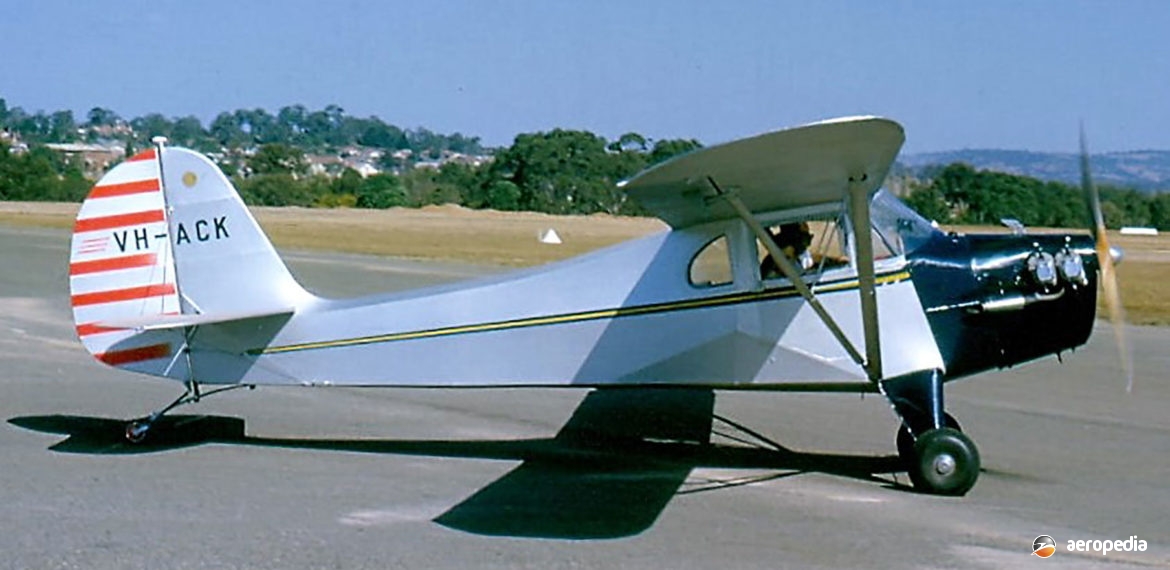Photograph:
Aeronca K Scout VH-ACK (c/n K162) at Camden, NSW in April 1965 (David C Eyre)
Country of origin:
United States of America
Description:
Two-seat light touring monoplane
Power Plant:
One 48 kw (65 hp) Continental C65 four-cylinder horizontally-opposed air-cooled engine
Specifications:
- Wingspan: 11 m (36 ft)
- Length: 6.4 m (21 ft)
- Height: 1.82 m (6 ft 3 in)
- Wing area: 15.7 m² (169 sq ft)
- Max speed: 169 km/h (105 mph)
- Cruising speed at 85% power: 153 km/h (95 mph)
- Stalling speed: 63 km/h (39 mph)
- Initial rate of climb: 168 m/min (550 ft/min)
- Service ceiling: 4,267 m(14,000 ft)
- Range at 85% cruising speed: 418 km (260 miles)
- Empty weight: 306 kg (675 lb)
- Useful load: 218 kg (480 lb)
- Loaded weight: 567 kg (1,250 lb)
History:
The Aeronca K Scout series of light aircraft was a side-by-side two-seat light cabin monoplane introduced to the Aeronca range of aircraft in 1937. Powered by a 30 kw (40 hp) Aeronca E-113-CBD engine, it was subsequently produced in a number of models with a variety of power plants to meet customer requirements. These included: Model KCA powered by a 37 kw (50 hp) Menasco M-50 engine and Model KF with a 37 kw (50 hp) Franklin 50 engine, which became known as the Aeronca Chief. Later the designations of these models were changed; the KCA becoming the 50-C and the KF becoming the 50-F. To these were added the 50-L with a 37 kw (50 hp) Lycoming engine, and the series of aircraft known as the Model 65, all powered by Continental, Franklin, or Lycoming engines of 48 kw (65 hp).
At least 350 examples were completed. One, fitted with Edo floats, was used by Henry Chapman to fly non-stop from New York to New Orleans in Lousiana, a distance of 1,899 km (1,180 miles) averaging 142 km/h (88 mph) in a time of 13½ hours in 1939. Another, flown by Johnnie Jones, an American Airlines DC-3 pilot, with 553 litres (122 Imp gals) on board, in 1938 flew non-stop from Los Angeles in California to New York in 30 hrs 47 mins, a distance of 4,482 km (2,785 miles) at 145 km/h (90 mph).
The fuselage was of welded steel tube, faired to shape with wooden formers and fairing strips, and was then fabric covered. There was an entry door on each side and dual wheel-type controls were optional. The wing was built in two halves, of solid spruce spar beams with spruce and plywood framework, and covered in fabric. Freise-type ailerons were of metal frame covered with fabric.
One example has been registered in Australia. VH-ACK (c/n K162 – ex NC1888) was first registered in December 1939. Prior to being brought to Australia this aircraft was operated on floats in the Antarctic by the American Lincoln Ellsworth Expedition. It had been presented to the expedition by its owners, the Vanderbilt family, which, reputedly, had used it for aerial duck-shooting on inland American lakes. It was withdrawn from use in Victoria in March 1977 and was placed in storage. It was later exported to Omaka near Blenheim in New Zealand where it was placed in storage pending a decision as to its restoration.

